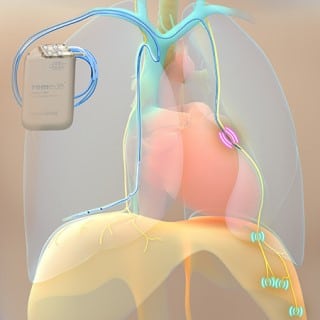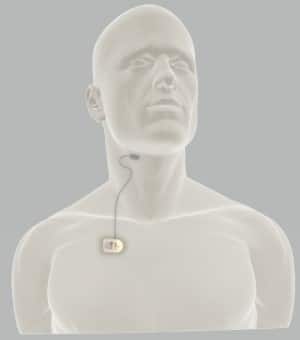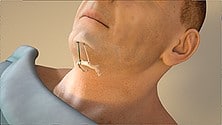
The Latest Sleep Apnea Devices – Everything You Need to Know
While CPAP is one of the most effective treatments for sleep apnea, many patients stop using their machines within a year. Good news, they’re now plenty of alternatives you can try.
The latest sleep apnea devices include more comfortable face masks, body positioners, innovative nerve stimulators, and surgically implanted suspension lines.
Here’s a more in depth look at your CPAP alternatives:
AIR PRESSURE TREATMENTS
Pros:
Cons:
Video: Provent Therapy demonstration
Video: How aerSleep Works
Video: Night Shift Introduction
NightBalance:
Video: NightBalance Overview
Video: New treatment for Sleep Apnea (CNN)
remedē System:

Video: remedē system helps patients with central sleep apnea at Saint Luke’s Hospital
GENIO Implantable Stimulator:
THN Sleep Therapy (aura6000):

Pros:
- minimally invasive, surgically implanted system usually as an outpatient procedure with quick recovery time
- procedure is completely reversible
- no masks, hoses, or mouthpieces
Cons: requires surgery, although minimal (all surgeries carry a risk)
Availability: In clinical trials
See if you qualify to participate
Cost: To be determined
Insurance coverage: To be determined
Made by: LivaNova
Phone: 858-259-2980
Learn more
SUSPENSION LINES
AirLift:

How it works: Uses suspension lines to reposition the hyoid bone or tongue to hold the airway open
Recommended for: obstructive sleep apnea
Proof it works: clinical studies (see “Publications”)
Pros:
- minimally invasive, well-tolerated
- reversible
- can be performed in an outpatient setting
- no mask or oral appliance to wear
Cons:
- surgery
- requires implant of screws and sutures which some may find intrusive or uncomfortable
Availability: US
Find an AIRLIFT trained Doctor
Insurance coverage: yes
Made by: Siesta Medical, Inc
Phone: 408-320-9424
E-mail: [email protected]
Learn more
Video: AirLift Procedure
Sources:
1. A novel nasal expiratory positive airway pressure (EPAP) device for the treatment of obstructive sleep apnea: a randomized controlled trial. Sleep. 2011; 34(4):479-85.
2. Nasal Expiratory Positive Airway Pressure Devices (Provent) for OSA: A Systematic Review and Meta-Analysis. Sleep Disord. 2015; 2015: 734798.
3. Evaluation of Continuous Negative External Pressure (cNEP) for the Treatment of Obstructive Sleep Apnea: A Pilot Study. J Clin Sleep Med. 2017; 13(8):1009-1012.
4. A multicenter evaluation of oral pressure therapy for the treatment of obstructive sleep apnea. Sleep Med. 2013 Sep;14(9):830-7.
5. Assessment of a neck-based treatment and monitoring device for positional obstructive sleep apnea. J Clin Sleep Med. 2014; 10(8):863-71.
6. Outcome after one year of upper airway stimulation for obstructive sleep apnea in a multicenter German post-market study. Laryngoscope. 2018; 128(2):509-515
7. Sustained 12 Month Benefit of Phrenic Nerve Stimulation for Central Sleep Apnea. Am J Cardiol. 2018; 121(11):1400-1408.
8. Transvenous neurostimulation for central sleep apnoea: a randomised controlled trial. Lancet. 2016; 388(10048):974-82.
9. Targeted hypoglossal nerve stimulation for the treatment of obstructive sleep apnea: Six-month results. Laryngoscope. 2016; 126(11):2618-2623.
10. Targeted hypoglossal neurostimulation for obstructive sleep apnoea: a 1-year pilot study. Eur Respir J. 2013; 41(2):360-7.
11. Weight loss for obstructive sleep apnea: the optimal therapy for obese patients. J Am Diet Assoc. 1994; 94(11):1291-5.
12. Alcohol and the risk of sleep apnoea: a systematic review and meta-analysis. Sleep Med. 2018; 42: 38–46.
13. Interaction between smoking and obstructive sleep apnea: not just participants. Chin Med J (Engl). 2012; 125(17):3150-6.
14. The role of sleep position in obstructive sleep apnea syndrome. Eur Arch Otorhinolaryngol. 2006; 263(10):946-50.
Connect with us:
About Us
Better Sleep Simplified® was founded as a place for you to get clear and well-researched information.
Our goal is to make sure you know about your options so that you take action sooner rather than later.
Check us out on YouTube:
Watch and Learn
Helpful sleep tips, interesting sleep facts and statistics you want to know about
Affiliate Disclosure
This site is a participant in the Amazon Services LLC Associates Program and other affiliate advertising programs designed to provide a means for sites to earn advertising fees by advertising and linking to them.
Important: BetterSleepSimplified.com is for informational purposes only and is not intended or implied to be a substitute for professional medical advice, diagnosis, or treatment. Always consult a physician for sleep and health concerns. See additional information.
